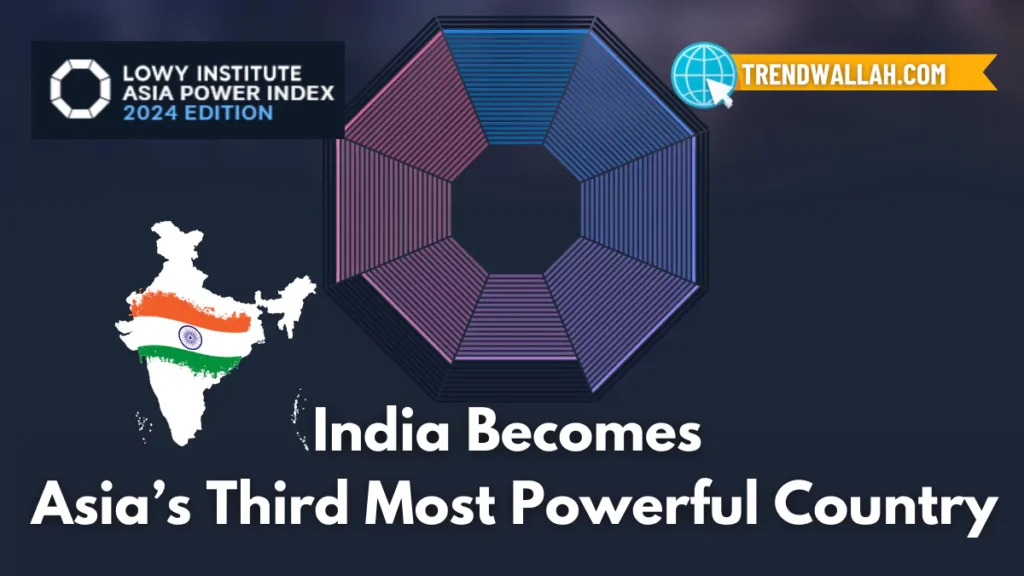
India has emerged as Asia’s third most powerful country, overtaking Japan, according to the Asia Power Index Report 2024 by the Lowy Institute. The report ranks countries based on their military, economic, diplomatic, and cultural influence in the region. India’s score increased to 39.1 in 2024, a 2.7-point rise from the previous year, reflecting its growing influence and power in Asia.
Factors Behind India’s Rise
India’s rise in the rankings can be attributed to several factors, especially its strong economic growth. In 2023-24, India achieved an 8.2% growth rate, leading major economies and boosting its economic capability score by 4.2 points. The country’s youthful population and large workforce are expected to further contribute to future resources and economic stability, positioning India well for future growth.
India has also strengthened its diplomatic efforts. Under Prime Minister Narendra Modi’s leadership, the country played a prominent role on the global stage, including hosting the G20 Summit in 2023. This increased India’s diplomatic influence, further enhancing its standing in the region.
Challenges for India
Despite its rise, the report points out that India faces challenges, particularly a negative power gap, which refers to the difference between the country’s resources and its actual influence. This gap has widened over the past year, increasing from -2.8 to -3.9 points. India’s decision to stay out of the Regional Comprehensive Economic Partnership (RCEP) has affected its economic ties with other Asian nations.
Another challenge is India’s relatively weak defense alliances. While the country has improved its defense capabilities, it lacks strong military partnerships that other major powers in the region enjoy, particularly those aligned with the United States.
Impact of India’s Rise on Asia and the World
India’s rise as the third most powerful country in Asia will have a significant impact on regional and global dynamics. As India continues to grow economically and diplomatically, it is expected to play a larger role in shaping the future of the Asia-Pacific region. Its influence may challenge China’s dominance and contribute to balancing power in the region.
On a global scale, India’s economic growth and political stability make it a key player in international trade and diplomacy. As the country strengthens its defense and economic ties, it will be better positioned to influence regional security and global trade policies.
India’s Future Potential
India’s young and growing population gives it a demographic advantage over many other Asian nations, including China, where the workforce is shrinking due to aging. This positions India to become a future economic and military powerhouse. However, to fully realize its potential, India must strengthen its economic ties within Asia and build stronger defense partnerships.
Table: Top 5 Most Powerful Countries in Asia (2024)
| Rank | Country | Score |
| 1 | United States | 81.7 |
| 2 | China | 72.7 |
| 3 | India | 39.1 |
| 4 | Japan | 38.9 |
| 5 | Australia | 31.9 |
India Becomes Asia’s 3rd Most Powerful Country- Key Summary
- India is ranked third in Asia Power Index 2024, overtaking Japan.
- India’s rise is driven by its strong economic growth and diplomatic influence.
- Challenges include a widening power gap and weaker defense partnerships.
- India’s growing influence is reshaping the regional power balance in Asia.
- India has the potential to become a leading global power with further growth and stronger alliances.
Check the Asia Power Index 2024 Report and India as Asia’s third Most Powerful Country.
Also Read- Defence Minister Rajnath Singh Inaugurates Sainik School in Jaipur
The Asia Power Index is an annual ranking by the Lowy Institute that measures the power of countries in Asia based on economic, military, diplomatic, and cultural factors.
India’s rise is mainly due to its strong economic growth, increased diplomatic efforts, and a large, young population.
India’s biggest challenge is its widening power gap, which indicates the country’s potential is not fully realized in terms of influence.
India’s young and growing workforce is expected to provide a demographic advantage, leading to sustained economic growth and increased power.
The top three countries are the United States, China, and India.
